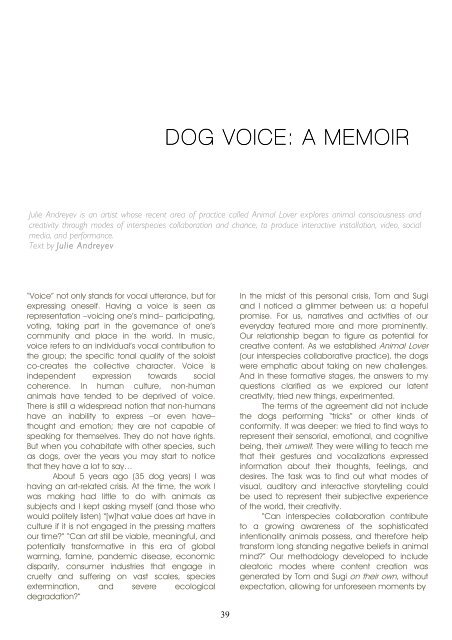Animal Influence I - Antennae The Journal of Nature in Visual Culture
Animal Influence I - Antennae The Journal of Nature in Visual Culture
Animal Influence I - Antennae The Journal of Nature in Visual Culture
You also want an ePaper? Increase the reach of your titles
YUMPU automatically turns print PDFs into web optimized ePapers that Google loves.
“Voice” not only stands for vocal utterance, but for<br />
express<strong>in</strong>g oneself. Hav<strong>in</strong>g a voice is seen as<br />
representation –voic<strong>in</strong>g one’s m<strong>in</strong>d– participat<strong>in</strong>g,<br />
vot<strong>in</strong>g, tak<strong>in</strong>g part <strong>in</strong> the governance <strong>of</strong> one’s<br />
community and place <strong>in</strong> the world. In music,<br />
voice refers to an <strong>in</strong>dividual’s vocal contribution to<br />
the group; the specific tonal quality <strong>of</strong> the soloist<br />
co-creates the collective character. Voice is<br />
<strong>in</strong>dependent expression towards social<br />
coherence. In human culture, non-human<br />
animals have tended to be deprived <strong>of</strong> voice.<br />
<strong>The</strong>re is still a widespread notion that non-humans<br />
have an <strong>in</strong>ability to express –or even have–<br />
thought and emotion; they are not capable <strong>of</strong><br />
speak<strong>in</strong>g for themselves. <strong>The</strong>y do not have rights.<br />
But when you cohabitate with other species, such<br />
as dogs, over the years you may start to notice<br />
that they have a lot to say…<br />
About 5 years ago (35 dog years) I was<br />
hav<strong>in</strong>g an art-related crisis. At the time, the work I<br />
was mak<strong>in</strong>g had little to do with animals as<br />
subjects and I kept ask<strong>in</strong>g myself (and those who<br />
would politely listen) “[w]hat value does art have <strong>in</strong><br />
culture if it is not engaged <strong>in</strong> the press<strong>in</strong>g matters<br />
our time?” “Can art still be viable, mean<strong>in</strong>gful, and<br />
potentially transformative <strong>in</strong> this era <strong>of</strong> global<br />
warm<strong>in</strong>g, fam<strong>in</strong>e, pandemic disease, economic<br />
disparity, consumer <strong>in</strong>dustries that engage <strong>in</strong><br />
cruelty and suffer<strong>in</strong>g on vast scales, species<br />
exterm<strong>in</strong>ation, and severe ecological<br />
degradation?”<br />
DOG VOICE: A MEMOIR<br />
Julie Andreyev is an artist whose recent area <strong>of</strong> practice called <strong>Animal</strong> Lover explores animal consciousness and<br />
creativity through modes <strong>of</strong> <strong>in</strong>terspecies collaboration and chance, to produce <strong>in</strong>teractive <strong>in</strong>stallation, video, social<br />
media, and performance.<br />
Text by Julie Andreyev<br />
39<br />
In the midst <strong>of</strong> this personal crisis, Tom and Sugi<br />
and I noticed a glimmer between us: a hopeful<br />
promise. For us, narratives and activities <strong>of</strong> our<br />
everyday featured more and more prom<strong>in</strong>ently.<br />
Our relationship began to figure as potential for<br />
creative content. As we established <strong>Animal</strong> Lover<br />
(our <strong>in</strong>terspecies collaborative practice), the dogs<br />
were emphatic about tak<strong>in</strong>g on new challenges.<br />
And <strong>in</strong> these formative stages, the answers to my<br />
questions clarified as we explored our latent<br />
creativity, tried new th<strong>in</strong>gs, experimented.<br />
<strong>The</strong> terms <strong>of</strong> the agreement did not <strong>in</strong>clude<br />
the dogs perform<strong>in</strong>g “tricks” or other k<strong>in</strong>ds <strong>of</strong><br />
conformity. It was deeper: we tried to f<strong>in</strong>d ways to<br />
represent their sensorial, emotional, and cognitive<br />
be<strong>in</strong>g, their umwelt. <strong>The</strong>y were will<strong>in</strong>g to teach me<br />
that their gestures and vocalizations expressed<br />
<strong>in</strong>formation about their thoughts, feel<strong>in</strong>gs, and<br />
desires. <strong>The</strong> task was to f<strong>in</strong>d out what modes <strong>of</strong><br />
visual, auditory and <strong>in</strong>teractive storytell<strong>in</strong>g could<br />
be used to represent their subjective experience<br />
<strong>of</strong> the world, their creativity.<br />
“Can <strong>in</strong>terspecies collaboration contribute<br />
to a grow<strong>in</strong>g awareness <strong>of</strong> the sophisticated<br />
<strong>in</strong>tentionality animals possess, and therefore help<br />
transform long stand<strong>in</strong>g negative beliefs <strong>in</strong> animal<br />
m<strong>in</strong>d?” Our methodology developed to <strong>in</strong>clude<br />
aleatoric modes where content creation was<br />
generated by Tom and Sugi on their own, without<br />
expectation, allow<strong>in</strong>g for unforeseen moments by












